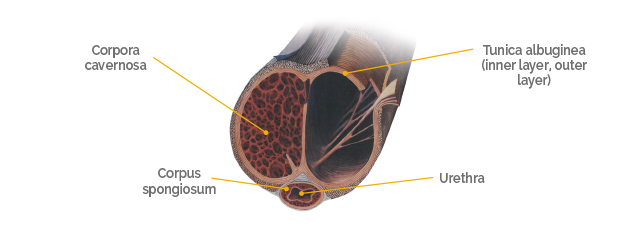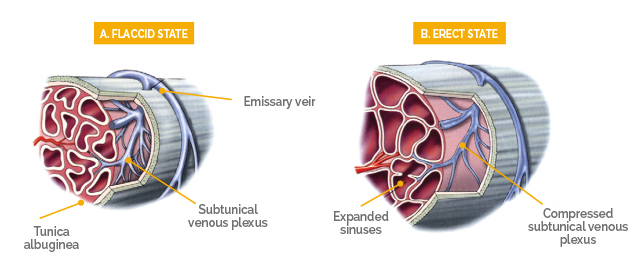
What is erectile dysfunction (ED)?
Erectile dysfunction or ED, commonly known as impotence, is the continual inability to achieve or maintain an erection sufficient for a mutually satisfactory intercourse with the partner.
National Institutes of Health (NIH) Consensus Development Conference on Impotence (December 7-9, 1992)
How does the penile erection occur?
The human penis is composed of three spongy cylindrical structures: the paired corpora cavernosa and the corpus spongiosum (which houses the urethra, the tube that carries urine from the bladder); these are covered by a loose subcutaneous layer and skin. The corpora cavernosa are surrounded by the tunica albuginea, a bilayer structure composed of outer longitudinal and inner circular layers. The tunica gives the penis great flexibility, rigidity, and tissue strength.

Mechanism of penile erection
A: Vessels (arteries, arterioles and sinusoids) are contracted when the penis is in the flaccid state. The veins are fully open and the blood can therefore flow freely in the emissary veins.
B: In the erect state, the relaxation of the muscles of the vessel wall allows maximal flow into the sinusoidal spaces, which expand. As a result, the penis swells and stiffens.

Penile erection is actually only a single component of a highly complex mechanism. Indeed, it results from the integration of different physiological processes involving the central nervous, peripheral nervous, hormonal, and vascular systems. Any abnormality in these systems, of whatever origin (psychological and stress-related factors, medication, local problems with the erection bodies or penis itself, disease), may have a significant impact on the ability to develop and sustain an erection, and thus to achieve orgasm and ejaculation.
Lue TE. Physiology of penile erection and pathophysiology of erectile dysfunction, In: Campbell-Walsh Urology, Kavoussi LR, et al., Editors. 2012, Saunders: Philadelphia. p. 688-720.






